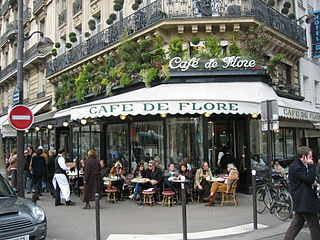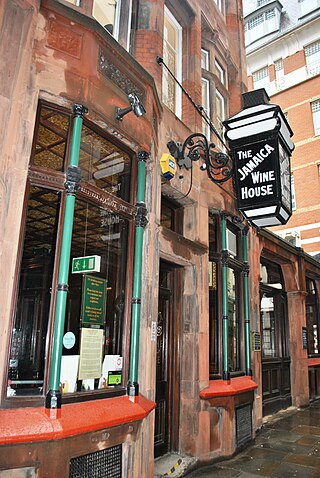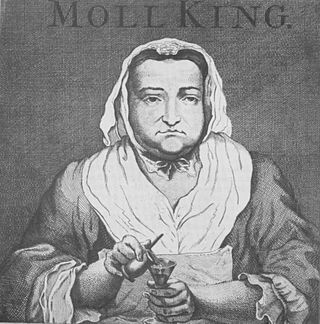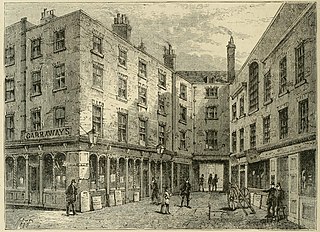
A coffeehouse, coffee shop, or café is an establishment that serves various types of coffee, espresso, latte, americano and cappuccino. Some coffeehouses may serve cold beverages, such as iced coffee and iced tea, as well as other non-caffeinated beverages. A coffeehouse may also serve food, such as light snacks, sandwiches, muffins, cakes, breads, donuts or pastries. In continental Europe, some cafés also serve alcoholic beverages. Coffeehouses range from owner-operated small businesses to large multinational corporations. Some coffeehouse chains operate on a franchise business model, with numerous branches across various countries around the world.

Turkish coffee is a style of coffee prepared in a cezve using very finely ground coffee beans without filtering.

Jonathan's Coffee House was a significant meeting place in London in the 17th and 18th centuries, famous as the original site of the London Stock Exchange.
Will's Coffee House was one of the foremost coffeehouses in England in the decades after the Restoration. It was situated in Russell Street in London, at the northwest corner of Bow Street, between the City and Westminster. According to the Methuen Drama Dictionary of the Theatre, it was also known as the Rose Tavern, the Russell Street Coffee House, and the Wits' Coffee House. It was founded by Will Urwin.

Coffee culture is the set of traditions and social behaviors that surround the consumption of coffee, particularly as a social lubricant. The term also refers to the cultural diffusion and adoption of coffee as a widely consumed stimulant. In the late 20th century, espresso became an increasingly dominant drink contributing to coffee culture, particularly in the Western world and other urbanized centers around the globe.

The Jamaica Wine House, known locally as "the Jampot", is located in St Michael's Alley, Cornhill, in the heart of London's financial district. It was the first coffee house in London and was visited by the English diarist Samuel Pepys in 1660. It is now a Grade II listed public house and is set within a labyrinth of medieval courts and alleys in the City of London. It lies in the ward of Cornhill.

Elizabeth Adkins, who was also known as Moll King, Moll Bird, Mary Godson, Mary and Maria Godson, was a prominent figure in London's underworld during the early 18th century. She owned King's Coffeehouse with her husband Tom King and she also allegedly worked in the sex trade and as a pickpocket.

Lloyd's Coffee House was a significant meeting place in London in the 17th and 18th centuries.

The Grecian Coffee House was a coffee house, first established in about 1665 at Wapping Old Stairs in London, United Kingdom, by a Greek former mariner called George Constantine.

Exchange Alley or Change Alley is a narrow alleyway connecting shops and coffeehouses in an old neighbourhood of the City of London. It served as a convenient shortcut from the Royal Exchange on Cornhill to the Post Office on Lombard Street and remains as one of a number of alleys linking the two streets. Shops once located in Exchange Alley included ship chandlers, makers of navigation instruments such as telescopes, and goldsmiths from Lombardy in Italy.

Queen's Lane Coffee House is a historic coffee house established by Cirques Jobson, a Levantine Jew from Syria. Dating back to 1654, it is the oldest continually serving coffee house in Europe, but it has only been on the present site since 1970. The building in which it operates is a Grade II listed building. It was in this coffee house where Jeremy Bentham discovered Utilitarianism.

In 17th- and 18th-century England, coffeehouses served as public social places where men would meet for conversation and commerce. For the price of a penny, customers purchased a cup of coffee and admission. Travellers introduced coffee as a beverage to England during the mid-17th century; previously it had been consumed mainly for its supposed medicinal properties. Coffeehouses also served tea and hot chocolate as well as a light meal.

The Canadian Pacific Building at 62–65 Trafalgar Square is an office building in Westminster in London, England. It was constructed as the London offices of the Canadian Pacific Railway Company and its affiliated steamship line, hotel chain, and other subsidiary companies. It is faced with Portland stone, features prominent CANADIAN PACIFIC signage, and houses a small clock tower.

Nando's was a coffee house in Fleet Street in London. It was known to exist in 1696, being the subject of a conveyance, and was popular in the 18th century, especially with the legal profession in the nearby courts and chambers.

Garraways Coffee House was a London coffee house in Exchange Alley from the period when such houses served as important places where other business was performed. Its original proprietor, Thomas Garway, was already said to be the first person in England to sell tea prior to the house's founding, and when he began to sell it here in 1657 it became the first place in England to do so. The Hudson's Bay Company conducted its first sale of furs at the coffee house in 1671.

The Sun Inn is a Grade II listed public house overlooking the village pond at 7 Church Road, Barnes in the London Borough of Richmond upon Thames. It was built as a coffee-house in the mid-18th century, but the architect is not known.

Morley's Hotel was a building which occupied the entire eastern side of London's Trafalgar Square, until it was demolished in 1936 and replaced with South Africa House. It was next to St Martin-in-the-Fields Church.

The Vienna Café was a coffee house and restaurant at 24–28 New Oxford Street, London. Located opposite Mudie's Lending Library and near the British Museum Reading Room in Bloomsbury, it became known in the early 20th century as a meeting place for writers, artists, and intellectuals. Regular visitors included Ezra Pound, H. G. Wells, and W. B. Yeats.

Button's Coffee House was an 18th-century coffeehouse in London, England. It was situated in Russell Street, Covent Garden, between the City and Westminster.

Monmouth Coffee Company is a coffee roaster, retailer and wholesaler in London, which was founded in 1978. It played an important role in regenerating Neal's Yard and Borough Market. It has remained focused on roasting and selling coffee beans and was one of the foundations for the third wave of coffee in London after the year 2000.



















